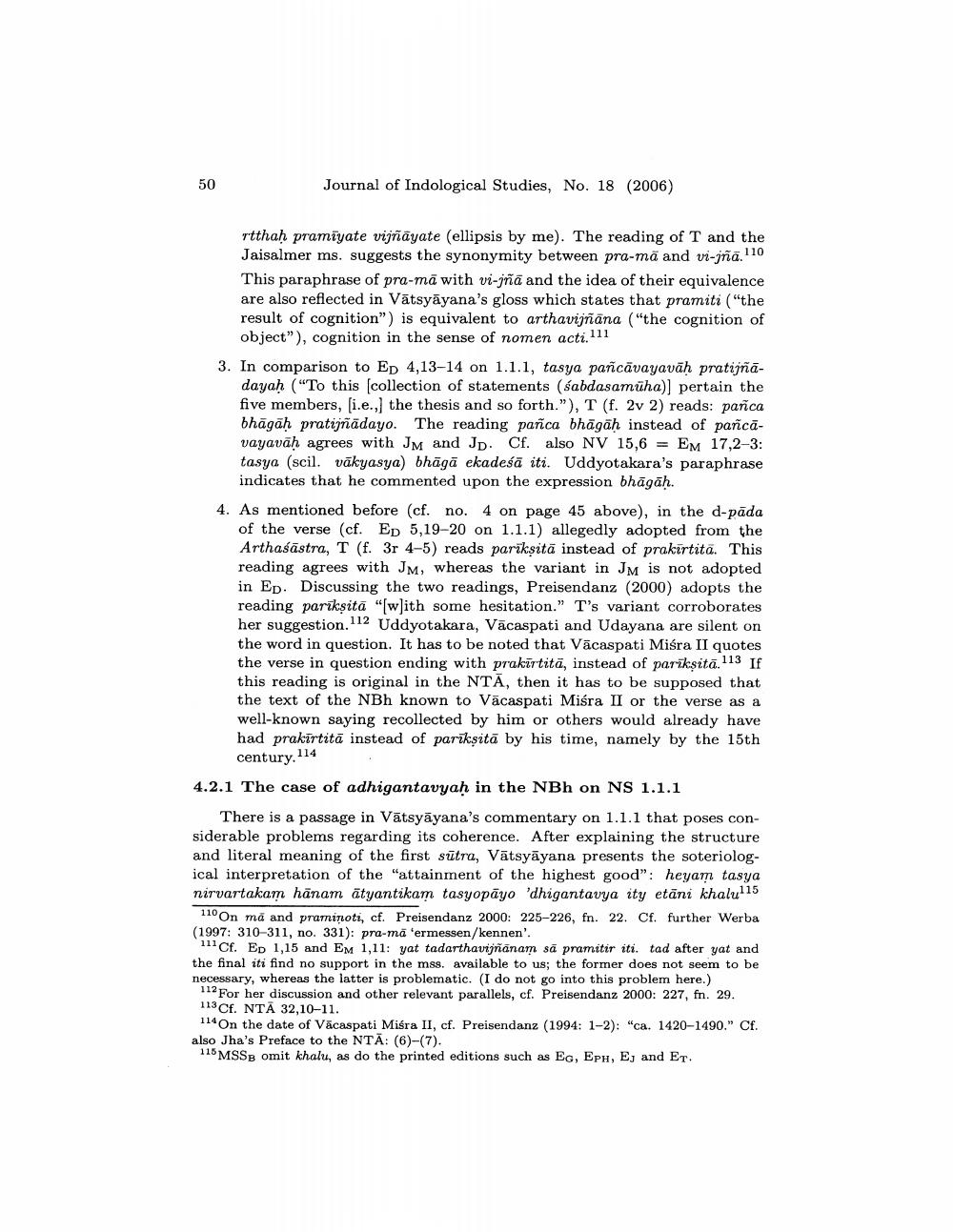________________
Journal of Indological Studies, No. 18 (2006)
rtthaḥ pramiyate vijñāyate (ellipsis by me). The reading of T and the Jaisalmer ms. suggests the synonymity between pra-mä and vi-jñā.110 This paraphrase of pra-mā with vi-jña and the idea of their equivalence are also reflected in Vātsyāyana's gloss which states that pramiti ("the result of cognition") is equivalent to arthavijñāna ("the cognition of
object"), cognition in the sense of nomen acti111 3. In comparison to ED 4,13-14 on 1.1.1, tasya pañcavayavah pratijñā
dayah ("To this (collection of statements (sabdasamüha)] pertain the five members, (i.e.,) the thesis and so forth."), T (f. 2v 2) reads: pañca bhāgāh pratijñādayo. The reading pañca bhāgāh instead of pañcāvayavāh agrees with JM and JD. Cf. also NV 15,6 = EM 17,2-3: tasya (scil. vākyasya) bhāgā ekadeśā iti. Uddyotakara's paraphrase
indicates that he commented upon the expression bhāgāh. 4. As mentioned before (cf. no. 4 on page 45 above), in the d-pāda
of the verse (cf. Ep 5,19-20 on 1.1.1) allegedly adopted from the Arthasāstra, T (f. 3r 4-5) reads pariksitā instead of prakirtita. This reading agrees with JM, whereas the variant in JM is not adopted in Ep. Discussing the two readings, Preisendanz (2000) adopts the reading parīkṣitā "[wlith some hesitation." T's variant corroborates her suggestion. 112 Uddyotakara, Vācaspati and Udayana are silent on the word in question. It has to be noted that Vācaspati Misra II quotes the verse in question ending with prakirtitā, instead of pariksitā.113 If this reading is original in the NTA, then it has to be supposed that the text of the NBh known to Vācaspati Miśra II or the verse as a well-known saying recollected by him or others would already have had prakirtitā instead of pariksitā by his time, namely by the 15th
century. 114 4.2.1 The case of adhigantavyah in the NBh on NS 1.1.1
There is a passage in Vātsyāyana's commentary on 1.1.1 that poses considerable problems regarding its coherence. After explaining the structure and literal meaning of the first sūtra, Vātsyāyana presents the soteriological interpretation of the "attainment of the highest good": heyam tasya nirvartakam hānam ātyantikam tasyopāyo 'dhigantavya ity etāni khalu 15
110 On mã and praminoti, cf. Preisendanz 2000: 225-226, fn. 22. Cf. further Werba (1997: 310-311, no. 331): pra-ma 'ermessen/kennen'.
111 Cf. Ep 1,15 and EM 1,11: yat tadarthavijnanam sa pramitir iti. tad after yat and the final iti find no support in the mss. available to us; the former does not seem to be necessary, whereas the latter is problematic. (I do not go into this problem here.) 12 For her discussion and other relevant parallels, cf. Preisendanz 2000: 227, fn. 29. 113 Cf. NTA 32,10-11. 114 On the date of Vācaspati Miśra II, cf. Preisendanz (1994: 1-2): "ca. 1420-1490." Cf. also Jha's Preface to the NTĀ: (6)-(7). 115 MSSB omit khalu, as do the printed editions such as EG, Eph, Ej and ET.




